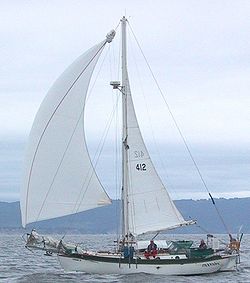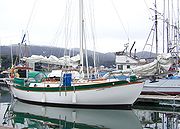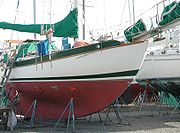
Westsail 32
Encyclopedia

Specifications
| Length Overall | 32' |
| Waterline Length | 27 in 6 in (8.38 m) |
| Beam | 11' |
| Draft | 5' |
| Displacement | 19500 lb (8,845.1 kg) |
| Ballast | 7000 lb (3,175.1 kg) |
| Sail Area | 629 sq ft (58.4 m²) |
Ref:
Origins

Colin Archer
Colin Archer was a Norwegian naval architect and shipbuilder from Larvik, Norway. His parents emigrated from Scotland to Norway in 1825....
. These boats were designed for extreme seaworthiness in the rough conditions of the North Sea.
The late 19th century Archer design was first adapted for pleasure sailing by William Atkin, who, in 1928, designed a 32 feet (9.8 m) double-ended boat called Eric based on Archer's 47’ pilot boat Regis Voyager. This design was later refined into Thistle, which replaced Erics gaff rig
Gaff rig
Gaff rig is a sailing rig in which the sail is four-cornered, fore-and-aft rigged, controlled at its peak and, usually, its entire head by a spar called the gaff...
with a bermuda rig
Bermuda rig
The term Bermuda rig refers to a configuration of mast and rigging for a type of sailboat and is also known as a Marconi rig; this is the typical configuration for most modern sailboats...
. Atkin's boats made impressive voyages, including the wartime circumnavigation of Vito Dumas
Vito Dumas
Vito Dumas was an Argentine single-handed sailor.In 1942, while the world was in the depths of World War II, he set out on a single-handed circumnavigation of the Southern Ocean. He left Buenos Aires in June, sailing Lehg II, a 31-foot ketch named for the initials of his mistress...
in Lehg II. An Eric design shot to prominence in 1969, when Robin Knox-Johnston
Robin Knox-Johnston
Sir William Robert Patrick "Robin" Knox-Johnston, CBE, RD and bar is an English sailor. He was the first man to perform a single-handed non-stop circumnavigation of the globe and was the second winner of the Jules Verne Trophy . For this he was awarded with Blake the ISAF Yachtsman of the Year award...
became the first person to sail single-handed
Single-handed sailing
The sport of single-handed sailing or solo sailing is sailing with only one crewmember . The term is usually used with reference to ocean and long-distance sailing, and particularly competitive sailing....
and non-stop around the world; his boat, Suhaili, was hand-built in India to the Eric design.
The Kendall 32
In 1969, Californian Larry Kendall decided that a boat like Suhaili would make his ideal long-distance cruiser, specially if built in glass-reinforced plasticGlass-reinforced plastic
Fiberglass , is a fiber reinforced polymer made of a plastic matrix reinforced by fine fibers of glass. It is also known as GFK ....
(GRP). A couple of his friends were also interested, and together they thought that moulding the boats from fibreglass would save some money. Kendall asked yacht designer William Crealock
W.I.B. Crealock
William Ion Belton Crealock was a yacht designer and author. He was one of the world's leading yacht designers from the 1960s through the 1990s, and his yachts were owned by the famous and wealthy, including Walter Cronkite and William Hurt.-Early years:Crealock was born in Westcliff-on-Sea,...
whether there might be a market for a heavily-built, long-distance, fibreglass cruising sailboat; Crealock's opinion was that "you might sell ten or a dozen". This was enough for Kendall to go into business, and Crealock set about converting the Atkin design to GRP, resulting in a hull shape essentially the same as the original Eric/Thistle. The resulting Kendall 32 was a limited success; the company was short-lived, however, and became insolvent after two years in operation.
Westsail Corporation
In February, 1971, S. Snyder Vick, a young electrical engineer, and his wife Lynne, bought the moulds for the Kendall 32 from Kendall Yacht Corporation. Kendall and five other employees were hired to continue production. Production started in 1969, beginning by finishing three boats for Kendall buyers for between $15,000 and $20,000 each; however, Crealock was asked to design a modified deck layout and interior, and the Westsail 32 was born.
Demise
Despite the company's sales success, it never achieved financial success. The usual practice of taking payment for a boat only upon delivery created a credit gap for the company, and this gap grew larger with the booming sales, as the number of boats in production at one time increased. This problem was exacerbated by the announcement of the new Westsail 42 and 43 in 1974; the new boats sold strongly from the preliminary sketches, but the larger boats involved an even longer build time and larger capital commitment. The commitment to deliver boats for a price agreed at the start of production made the company especially vulnerable to inflation in materials costs. In an effort to meet demand while reducing the strain on production, many boats were sold as kits. A book was written to accompany the kit, Ferenc MátéFerenc Máté
Ferenc Máté escaped Hungary after the revolution with his mother to Vancouver, British Columbia. He has lived in British Columbia, California, New York, Paris, and Rome, and now resides on a wine estate in Tuscany with his wife, painter and winemaker Candace Máté, and their son, Peter...
's From a Bare Hull; a later edition of this book is still selling as a popular reference on home boatbuilding. Also see "The Finely Fitted Yacht" by the same author.
The Vicks' business inexperience, and lax production efficiency, meant that despite technically showing a profit, the company struggled to stay solvent. The firm went into bankruptcy proceedings in early 1977. Although the company restarted under new management, the financial problems continued, and Westsail Corporation ceased operation finally in 1981. The firms' achievement remains impressive, however; in just ten years the company built some 830 Westsail 32s (as well as the 28s, 42s, and 43s built), a phenomenal rate of production for such a large boat, and made a lasting impact on the world of cruising yachts.
Design

Construction
The construction is extremely heavy, which appeals to many prospective cruisers. The hull is made of hand-laid fibreglass, in 12 layers, alternating woven roving with chopped strand mat, set in polyester resin. This results in a solid hull whose thickness ranges from half an inch at minimum to almost an inch. This is considerably more than most equivalent boats. The deck is half-inch plywood sheathed in GRP; the bulkheads are also plywood, tabbed to the hull with fibreglass cloth. The ballast is 7000 lb (3,175.1 kg), either lead and iron (earlier boats) or all lead, installed inside the keel (which is part of the hull shape) and set in resin.The trade-off for the construction strength is weight; at 19500 lb (8,845.1 kg), the Westsail is exceptionally heavy for a 32 feet (9.8 m) boat. This hampers performance, but on the other hand, Westsails are affected relatively less by the large weight of stores and equipment required for long-term cruising (2 tons or more is quite typical).
The 400 kit boats sold were (except for a few) sold as complete hulls with ballast installed and the deck bonded on; it remained for the owner to fit out the interior and deck.
Deck and sail plan
Most Westsail 32s were rigged as cutters; i.e. with a single mast, mainsail, forestaysail and jib. The forestay terminates on the bow; a six-foot bowsprit supports the headstay, and the backstay terminates on a short boomkin, bringing the overall length with appendages of the typical boat to 40 feet (12.2 m). The shroud chainplates are bolted to the outside of the hull, making for a strong and reliable design, with clear side decks, at the expense of some sheeting angle for the jib.The deck layout is geared towards ocean sailing, with wide side decks giving easy access forwards, and high bulwarks with high lifelines for safety. The cockpit is very small; this helps seaworthiness, as the weight of water which can be loaded onto the boat by a wave is limited. However, comfort in the cockpit is not helped.
Interior
The payoff for the short cockpit is a surprisingly roomy interior. The boat's maximum beam, already roomy at 11 feet (3.4 m), is carried much farther forward than in most boats; coupled with a headroom of 6 in 2 in (1.88 m), this produces a remarkably spacious interior.A number of different interior layouts were produced at the factory, with an even greater variety produced by home builders of the 400 kit boats sold. A typical layout will feature a galley and sizeable navigation station with a quarter berth aft, with two sofas or a sofa and dinette, a head and hanging locker, and a V-berth forwards. A common layout had pilot berths behind the settees. The quality of finish in the kit boats varies enormously, with some being well above factory standards.
Performance and seaworthiness
The Westsail's no-compromise approach to seaworthiness is carried through into her sailing performance. The heavy, full-keeled hull makes for good tracking offshore, coupled with a safe-feeling and quiet ride, but with limited performance. The overall effect is that the boat will get to wherever it is headed, but that it may take a while. Nevertheless, the Westsail is praised by many owners for being able to make a reasonable pace, particularly with a good wind. Indeed, in the right conditions the boat can perform well, as seen in the 1988 Pacific Cup, won (on corrected time) by the Westsail 32 Saraband in relatively light winds. The same boat finished third in 1990.The Westsail's seaworthiness is attested by many stories of groundings, rollovers, and even collisions with freighters survived by the boats. A well-known example is Satori, a Westsail 32 which was abandoned during the famous Halloween storm of 1991, but which survived despite being washed up on shore.
Impact
The Westsail 32 had a tremendous impact on the cruising world, and on the boat industry. The most immediate impact, of course, was on the 800-plus owners of the boats built. With her massive no-nonsense construction, the Westsail largely delivered on the promise of a boat that could take its owners anywhere in the world, and surprisingly many boats have in fact been sailed to exotic locations, even if performance was a disappointment for many owners. The overwhelming majority of the boats are still fully seaworthy, and hold their resale value very well.Westsails continue to be cited as the epitome of a seaworthy cruising boat. In discussions of seaworthiness versus performance, the design is frequently cited as "one end of the spectrum" (for either good or ill). The Westsail's reputation is usually summed up as "built like a tank, but unfortunately sails like one too". Nevertheless, the boat is still often praised as a design which "has a larger, nicer interior; can carry more, is more comfortable to live aboard at anchor and during passages; will last longer; will be more forgiving of owner neglect and mistakes; has a better chance of surviving groundings and other mishaps; and quite likely will hold its value better".
The success of the Westsail spawned many imitations, and led to a huge revival in "Archer-Atkin" double-ended designs, with boats such as Babas, Tashibas, Pandas, Hans Christians, Lord Nelsons, CTS, Union Cutters, Alejuelas, Tayanas, Willards, Dreadnaughts, Prairie Cutters, Pacific Seacrafts, and more. Subsequent designs, however, have sought to improve on the Westsail's sluggish performance, typically featuring a cutaway forefoot, lighter build, and larger sail plan. Many of these boats were built more cheaply in Taiwan.

